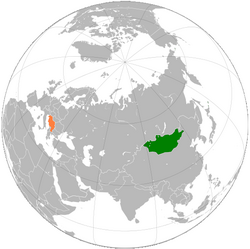Mongolia–Yugoslavia relations
 | |
Mongolia |
Yugoslavia |
|---|---|
Mongolia–Yugoslavia relations were historical foreign relations between Mongolian People's Republic and now split-up Socialist Federal Republic of Yugoslavia. Formal bilateral relations between Mongolia and Yugoslavia were established on 20 November 1956.[1] This was the period of normalization of Yugoslav relations with other Eastern Bloc countries which were either suspended or significantly strained after the 1948 Tito-Stalin split.
During the Cold War period Mongolia closely followed Soviet Union in its policies towards Yugoslavia.[2] During the 1968 Ulan Bator meeting government delegations of the two countries expressed identical views on the situation in Vietnam, condemned aggression and expressed hope for negotiations which will start soon.[3] Yugoslav delegation was led by President of Yugoslavia Josip Broz Tito.[3] Two countries signed agreement on scientific and cultural cooperation in 1985 as well as an agreement on provision of development aid to Mongolia.[1]
Normalization of relations between Soviet Union and Yugoslavia in 1953 after Stalin's death and Belgrade declaration resulted in Vyacheslav Molotov's expellsion from the Presidium after which he was made ambassador to the Mongolian People's Republic.[4]
Country comparison
| Common name | Mongolia | Yugoslavia |
|---|---|---|
| Official name | Mongolian People’s Republic | Socialist Federal Republic of Yugoslavia |
| Coat of arms |  |
 |
| Flag |  |
 |
| Capital | Ulaanbaatar | Belgrade |
| Largest city | Ulaanbaatar | Belgrade |
| Government | Unitary multi-party constitutional republic | Federal socialist republic |
| Population | 2,318,000 (1991) | 23,229,846 (1991) |
| Official languages | Mongolian | No official language
Serbo-Croatian (de facto state-wide) Slovene (in Slovenia) and Macedonian (in Macedonia) |
| Official script | Mongolian Cyrillic and Mongolian script | Cyrillic and Latin |
| First leader | Peljidiin Genden | Josip Broz Tito |
| Last leader | Punsalmaagiin Ochirbat | Milan Pančevski |
| Religion | State atheism (official) | Secular state (de jure), state atheism (de facto) |
| Alliances | Comecon | Non-Aligned Movement |
See also
- Yugoslavia and the Non-Aligned Movement
- World War II in Yugoslavia
- Mongolia in World War II
- Mongolia at the 1984 Winter Olympics
- Mongol invasion of Europe
References
- ^ a b "Монголија". Ministry of Foreign Affairs (Serbia). Retrieved 15 February 2021.
- ^ A. Rupen, Robert (1963). "Mongolia in the Sino-Soviet Dispute". The China Quarterly (16): 75–85. Retrieved 15 February 2021.
- ^ a b Daily Report, Foreign Radio Broadcasts. Washington D.C.: Foreign Broadcast Information Service. 16 April 1968.
- ^ Kullaa, Rinna Elina (2008). FROM THE TITO-STALIN SPLIT TO YUGOSLAVIA'S FINNISH CONNECTION: NEUTRALISM BEFORE NON-ALIGNMENT, 1948-1958 (PDF) (Doctor of Philosophy). University of Maryland. Retrieved 15 February 2021.



